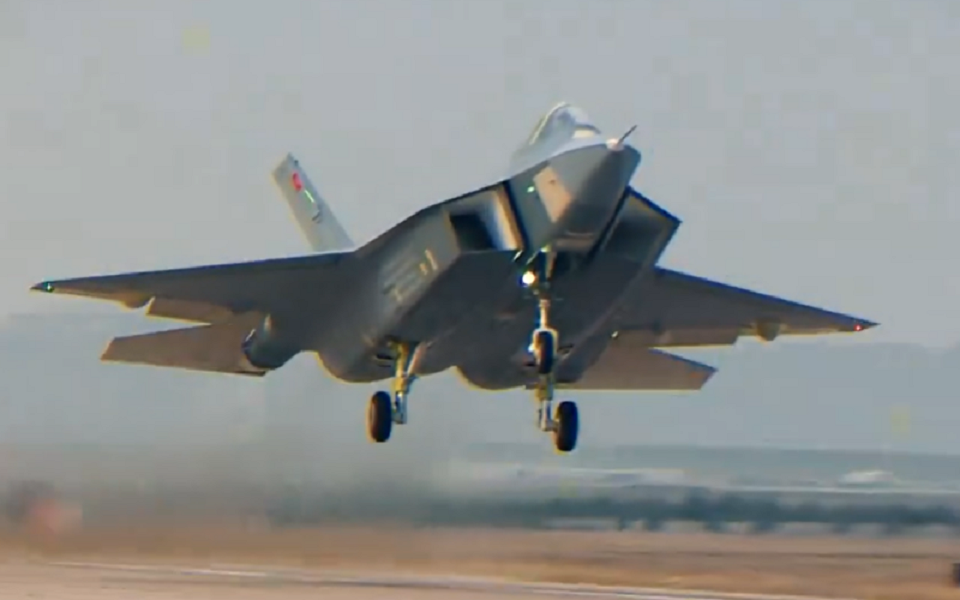Defence
Türkiye’s homegrown KAAN fighter jet completes first flight

Turkey’s fifth-generation fighter jet in development, the KAAN, achieved a significant milestone on Wednesday as it completed its inaugural flight.
Supervised by Turkish Aerospace Industries (TAI), the historic flight saw Commander Barbaros Demirbas of the Turkish Air Force take the helm. Lasting 11 minutes, the flight soared to an altitude of 8,000 feet (2,400 meters) and reached a speed of 230 knots (425 kilometers per hour).
The KAAN fighter jet, measuring 21 meters in length with a wingspan of 14 meters and standing 6 meters tall, marks a pivotal advancement in Turkey’s domestic aviation capabilities. With a maximum takeoff weight of approximately 27,215 kg, powered by two GE F110 engines boasting a combined thrust capacity of 76.31 kilonewtons and an afterburner thrust capacity of 131 kilonewtons, the KAAN demonstrates formidable performance. Its top speed of 2,716 km/h and combat range of up to 1,100 km signify its readiness for various operational scenarios.
Anticipated to integrate cutting-edge technologies, including a next-generation active electronically scanned array (AESA) radar system, sophisticated communications systems, and superior electronic warfare capabilities, the KAAN heralds a new era in Turkish military aviation. Advanced stealth features such as radar-absorbing materials and state-of-the-art coatings contribute to its reduced radar cross-section, enhancing its survivability in contested environments.
TAI, the lead contractor for the KAAN fifth-generation fighter jet development programme, plans to supply 20 KAAN Block 10 fighter jets to the Turkish Air Force by 2028 after taxi trials conclude in March. With an eye towards the future, the second prototype (P1), which will cover the full flight envelope and serve as a closer approximation to the intended production aircraft, is slated for takeoff in 2025. The anticipated third aircraft flight in 2026 and the delivery of follow-on blocks by 2034 are among the upcoming benchmarks.
The block 20 aircraft, with its supercruise capabilities and appropriate materials, coatings, sensors, and electronics, will represent the real fifth-generation fighter by 2034. Turkey’s dedication to developing its domestic defense sector and maintaining its standing as a major participant in the international aerospace arena is demonstrated by the KAAN project.

Defence
Russia’s NV.17 Hybrid Helicopter Aims to Balance Light and Heavy Helicopter Needs

As Western sanctions continue to impact Russia’s aviation sector, the country is making significant strides in advancing its domestic aerospace capabilities.
Despite the ongoing challenges, Russia has unveiled the Heliburo HB.17, a cutting-edge hybrid-powered medium-class helicopter that promises to reshape both commercial and military aviation.
The helicopter is currently in the technical design phase, with plans for its first flight slated for 2027. This marks a major step forward in Russia’s efforts to modernize its aviation fleet and reduce reliance on foreign technology.
This country tops visa rejections in the popular Schengen countries
The HB.17 is designed as a versatile, multi-role aircraft, capable of performing a wide range of functions. It is built to handle cargo transport, passenger carriage, reconnaissance, and close air support missions. With its robust design and flexible capabilities, the HB.17 is expected to meet the needs of both military and commercial operators, offering a solution for missions requiring a greater capacity than light helicopters but avoiding the limitations of larger aircraft.
One of the most innovative features of the HB.17 is its hybrid power plant. This combination of conventional and electric technologies enhances fuel efficiency, allowing the helicopter to stay airborne for up to seven hours without needing to refuel.
This extended operational endurance makes the HB.17 particularly well-suited for long-duration missions, providing a significant advantage over traditional helicopters. Additionally, the HB.17 will be equipped with modern avionics, ensuring advanced navigation, communication, and operational capabilities.
Qatar Airways Cargo and MASkargo Launch New Strategic Partnership
The HB.17 is positioned to compete with other medium-class helicopters such as the Kamov Ka-60/62 and the Mil Mi-38. However, its hybrid powerplant and modern avionics set it apart, offering a more efficient and technologically advanced alternative.
Its multi-role versatility, combined with its fuel efficiency and cutting-edge systems, gives it a competitive edge in the evolving aviation landscape. The introduction of the HB.17 follows recent reports of Russia receiving a new batch of armored vehicles from the UAE-based Streit Group.
Russia has traditionally focused on producing helicopters for defense purposes, but this time, it appears to be venturing into the civilian helicopter market with the HB.17.
This, along with the ongoing development of the HB.17, reflects Russia’s continued efforts to modernize its military assets and increase its self-reliance, even as sanctions continue to pressure its defense and aerospace sectors.
As Russia faces mounting geopolitical challenges, the HB.17 stands as a symbol of resilience, technological innovation, and determination to maintain its military and aviation capabilities.
-

 Aviation2 months ago
Aviation2 months agoMicrosoft Flight Simulator Raises $3 Million to Bring Back the An-225 Mriya
-

 Airlines2 months ago
Airlines2 months agoQatar Citizens Can Travel to the United States Without a Visa
-

 Aviation2 months ago
Aviation2 months agoQatar Airways bans these new Electronic Devices on plane
-

 Defence2 months ago
Defence2 months agoWhich Country Has the Largest Fleet of Fighter Aircraft?
-

 Airlines5 days ago
Airlines5 days agoDAMAC Air: Dubai’s New Luxury Airline Offers Free Flights for Registration
-

 Airport2 months ago
Airport2 months agoWestern Sydney Airport Welcomes Its First Plane After 6 Years of construction
-

 Airlines4 days ago
Airlines4 days agoAir India to Launch aircraft maintenance training institute in Bengaluru
-

 Aviation2 months ago
Aviation2 months agoDid you know ? Once Boeing 747 carried 1088 passenger in 1991








